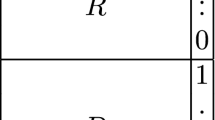Abstract
In a recent paper, Pawale (Des Codes Cryptogr, 2010) investigated quasi-symmetric 2-(v, k, λ) designs with intersection numbers x > 0 and y = x + 2 with λ > 1 and showed that under these conditions either λ = x + 1 or λ = x + 2, or \({\mathcal{D}}\) is a design with parameters given in the form of an explicit table, or the complement of one of these designs. In this paper, quasi-symmetric designs with y − x = 3 are investigated. It is shown that such a design or its complement has parameter set which is one of finitely many which are listed explicitly or λ ≤ x + 4 or 0 ≤ x ≤ 1 or the pair (λ, x) is one of (7, 2), (8, 2), (9, 2), (10, 2), (8, 3), (9, 3), (9, 4) and (10, 5). It is also shown that there are no triangle-free quasi-symmetric designs with positive intersection numbers x and y with y = x + 3.
Similar content being viewed by others
References
Baartmans A., Shrikhande M.S.: Designs with no three mutually disjoint blocks. Discrete Math. 40, 129–139 (1982).
Beth T., Jungnickel D., Lenz H.: Design Theory, 2nd ed., Vols. 1,2. Cambridge University Press, Cambridge (1999).
Bracken C., McGuire G., Ward H.N.: New quasi-symmetric designs constructed using mutually orthogonal Latin squares and Hadamard matrices. Des. Codes Cryptogr. 41, 195–198 (2006).
Calderbank A.R.: Geometric invariants for quasi-symmetric designs. J. Comb. Theory (A).47, 101–110 (1988).
Calderbank A.R.: Inequalities for quasi-symmetric designs. J. Comb. Theory (A). 48(1), 53–64 (1988).
Cameron P.J.: Quasi-symmetric 2-designs possessing a spread, In: Barlotti A. et al. (eds.), Combinatorics’88. Mediterranean Press, pp. 231–236. Rome, Italy (1992).
Hughes D.R., Piper F.C.: Design Theory. Cambridge University Press, Cambridge (1985).
Jungnickel D., Tonchev V.D.: Polarities, quasi-symmetric designs, and Hamada’s conjecture. Des. Codes Cryptogr. 51, 131–140 (2009)
Klin M.H., Woldar A.J.: The strongly regular graph with parameters (100, 22, 0, 6): Hidden history and beyond. preprint.
Lam C.W.H., Tonchev V.D.: Classification of affine resolvable 2−(27, 9, 4) designs. J. Stat. Plann. Inference 56(2), 187–202 (1996).
Limaye N.B., Sane S.S., Shrikhande M.S.: The structure of triangle-free quasi-symmetric designs. Discrete Math. 64, 199–207 (1987).
Majumdar K.N.: On some theorems in combinatorics related to incomplete block designs. Ann. Math. Stat. 24, 377–389 (1953)
Mavron V.C., Shrikhande M.S.: Designs with intersection numbers 0 and 2. Arch. Math. 52, 407–412 (1989).
Mavron V.C., McDonough T.P., Shrikhande M.S.: Quasi-symmetric designs with good blocks and intersection number one. Des. Codes Cryptogr. 28, 147–162 (2003).
Maxima, a Computer Algebra System. Version 5.18.1 http://maxima.sourceforge.net (2009).
McDonough T.P., Mavron V.C.: Quasi-symmetric designs with good blocks. J. Comb. Des. 3, 433–441 (1995).
McDonough T.P., Mavron V.C., Ward H.N.: Amalgams of designs and nets. Bull. Lond. Math. Soc. 41, 841–852 (2009)
Meyerowitz A., Sane S.S., Shrikhande M.S.: New results on quasi-symmetric designs-an application of MACSYMA. J. Comb. Theory (A). 43(1), 277–290 (1986).
Pawale R.M.: Quasi-symmetric 3-designs with triangle-free graph. Geom. Dedicata. 37, 205–210 (1991).
Pawale R.M.: Non existence of triangle free quasi-symmetric designs. Des. Codes Cryptogr. 37, 347–353 (2005).
Pawale R.M.: Quasi-symmetric designs with fixed difference of block intersection numbers. J. Comb. Des. 15, 49–60 (2007)
Pawale R.M.: Quasi-symmetric designs with the difference of block intersection numbers two. Des. Codes Cryptogr. (2010). doi:10.1007/s10623-010-9384-x.
Pawale R.M.: A note on triangle free quasi-symmetric designs, (preprint). (2010).
Sane S.S., Shrikhande M.S.: Some characterizations of quasi-symmetric designs with a spread. Des. Codes Cryptogr. 3, 155–166 (1993).
Shrikhande M.S.: Designs with triangle free graph. In: Proceedings of the seminar on Combinatorics and Applications in honour of Prof. S.S. Shrikhande on his 65th birthday, Indian Staistical Institute, pp. 30–37, December 14–17 1982.
Shrikhande M.S., Sane S.S.: Quasi-Symmetric Designs, London Mathematical Society, Lecture Note Series 164, Cambridge University Press, Cambridge (1991).
Author information
Authors and Affiliations
Corresponding author
Additional information
Communicated by D. Ghinelli.
Rights and permissions
About this article
Cite this article
Mavron, V.C., McDonough, T.P. & Shrikhande, M.S. On quasi-symmetric designs with intersection difference three. Des. Codes Cryptogr. 63, 73–86 (2012). https://doi.org/10.1007/s10623-011-9536-7
Received:
Revised:
Accepted:
Published:
Issue Date:
DOI: https://doi.org/10.1007/s10623-011-9536-7




